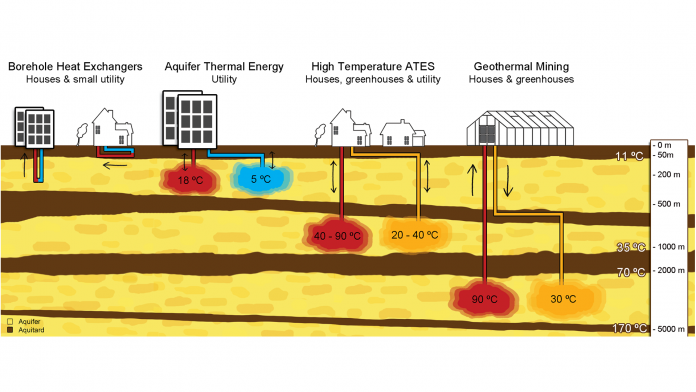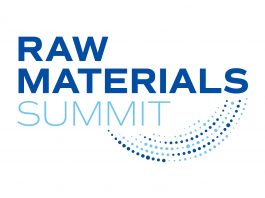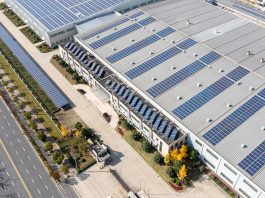Phil Vardon, Martin Bloemendal, Evert Slob, and David Bruhn from Delft University of Technology discuss recent research in accelerating geothermal technologies for the energy transition.
The most known geothermal installations worldwide are power plants for electricity generation concentrated in areas with recent volcanic activity and corresponding high temperatures at shallow depths. In the energy transition, however, focus on heating as the primary energy demand, requiring much lower temperatures, has increased considerably.
As a result, it is now recognised that geothermal energy is available everywhere, as it generally corresponds to the thermal energy stored in the Earth’s crust. According to an IPCC report,1 the technical potential for geothermal electricity generation worldwide is 17.5 EJ/yr (down to 3km depth) to a maximum of 1,108.6 EJ/yr down to 10km depth. For direct use of geothermal energy for heating purposes (temperatures <130°C), the geothermal technical potential has been estimated to be 41.6 EJ/yr with a lower value of 9.5 EJ/yr and an upper value of 312.2 EJ/yr (equivalent to 33,000 GWth of installed capacity).
Beyond its ubiquitous technical potential, geothermal energy has several well-known advantages, which include its availability for direct use for heating and cooling, both in residential and industrial applications. Worldwide, the heating and cooling sectors have the highest energy demand of all sectors and generate the highest CO2 emissions.2 Thus, the direct use of geothermal energy has a huge potential to reduce our dependency on fossil fuels and related greenhouse gas (GHG) emissions. Unlike other renewable energy sources, geothermal energy is available locally, also in densely populated areas, all of the time.
The subsurface also offers the required conditions for large volumes of seasonal thermal energy storage, accommodating the heating supply-demand gap because of diurnal and seasonal fluctuations. Moreover, excess thermal energy from other sources can also be stored and made available when demand exceeds the supply of thermal energy from renewable sources. Thermal energy storage can be accommodated in aquifers (ATES – aquifer thermal energy storage); in deep boreholes via borehole heat exchangers; or in abandoned mines, which are usually flooded and contain large volumes of water. Seasonal thermal energy storage also allows the storage of excess thermal energy from power conversion, thus accommodating sector coupling and hybrid solutions combining several energy sources (including green hydrogen production). Fig. 1 gives an overview of several geothermal technologies for direct thermal energy use.
In addition to their direct utilisation for energy generation, geothermal fluids can serve as sources of valuable minerals. In many places in Europe and the Americas, lithium concentrations have been found high enough for commercial extraction.3,4 In New Zealand, the large-scale extraction of industry-grade silica has been established. The potential for silica as a by-product exists in many high-enthalpy geothermal regions. Thus, geothermal fluids can contribute to the provision of critical raw materials required for other energy technologies.5
Geothermal energy is not fulfilling its potential
Despite having these key characteristics which make it an extremely valuable energy source, geothermal energy is currently not fulfilling its potential.6 Due to lower temperatures and, therefore, depths required, geothermal technology for heating purposes can be significantly more widespread than for electricity generation only. But lower temperatures result in lower energy density, together with a highly fluctuating demand and multiple users who need to be near the geothermal project, make the realisation of such projects challenging. Therefore, cheaper installations are needed, multiple installations are needed close together, and installations must be brought closer to the urban environment – preferably within city limits.
On top of this, where we are making changes to existing heating methods, buildings may have to be modified (usually upgraded) to allow for heating provision by a lower temperature heat source and/or centralised system – and this centralised distribution system needs to be installed. These characteristics mean that there are challenges that need to be addressed for geothermal energy to meet its potential and for us all to ensure the energy transition occurs. Policies need to support these challenges, and in a comprehensive way – not addressing just a single challenge.
More attention is needed to research wide aspects at a realistic scale and conditions which allow multiple aspects to be investigated to support large-scale adoption. This can also act as a demonstration which provides open insight into the possibilities of such systems. Focus is needed on energy systems. For example, how can thermal energy be produced, stored, distributed, and used in an optimal way, such that long-term, reliable, sustainable, and cost-effective energy supply can be guaranteed.
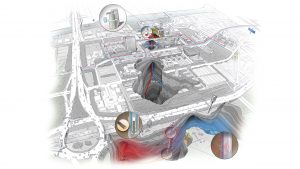
The Delft Subsurface Urban Energy Lab
To contribute to solving the challenges associated with geothermal energy, TU Delft, along with partners, has developed the Delft Subsurface Urban Energy Lab. This is a combination of facilities within a geothermal heating system that operate at full scale and are also used for research, development, and education (Fig. 2). It is a facility that is designed to address challenges both now and in the future via the installation of a significant amount of instrumentation and collection of baseline samples. Heating demand comes from the university campus and a nearby area of the city of Delft, with a combination of small and large users, which are both commercial and residential, i.e., an urban environment representative for many other cities.
The university and commercial partners (Aardyn, EBN and Shell Geothermal) formed a partnership to satisfy a joint aim of supplying this demand via geothermal energy and undertaking research. The facility is a whole energy system, with supply, storage, conversion distribution, and demand together. Parts of the research infrastructure have been installed in 2022, with other components being installed throughout 2023 and onwards. As this is a true operational and research facility, insights into the societal benefits and impacts, policy impacts and economics can be made as well. This is a key element in the energy lab because the technical focus is often prioritised, while societal aspects are vitally important in the heat transition and using subsurface resources.
The geothermal project is at the heart of the facility. Hot water at around 80°C will be produced at a rate of up to 400m3 per hour from one well from around 2.5km deep and reinjected into the same underground reservoir via a second well after thermal energy is extracted. The return temperature governs the heating power, and this will be maximised when heat demand is high via a large heat pump.
Research focuses on the behaviour of the subsurface and resource utilisation. The key questions are: how can we best understand the fluid and heat flow behaviour in the subsurface, and how does this influence the project lifetime and any unwanted impacts? A major societal concern is whether seismicity could occur. As fluid is reinjected (unlike in gas extraction projects), there is a limited influence from the fluid pressure, but as the reservoir rocks cool, they also contract. However, there has not been measured seismicity in geothermal projects in this geological setting; therefore, it is a key question why not. To investigate the key questions, we are installing fibreoptic cables to measure the temperature, pressure, and acoustic emissions in both wells, taking extensive rock cores and installing a local seismic monitoring station (see Fig. 3). In addition, we will install a dedicated monitoring and exploration borehole, which will be equipped with electromagnetic geophysical instruments (and other instrumentation) to around 4.5km deep. This is targeted to allow a 3D image of the hot and cold fluid in the reservoir, allowing key insights into how geothermal fluids move in such a reservoir – one which was created by millions of years of river meanders. The research infrastructure is funded by the Dutch Research Council (NWO) via two main projects (EPOS-NL and EPOS-eNLarge).
Heat storage
Geothermal energy projects can provide energy 24 hours per day, 365 days per year, and as a result, there is a heat surplus in summer, while capacities are usually insufficient to provide peak demand in winter. Seasonally storing thermal energy at temperatures ranging from 50-90°C in constructed storage systems such as tanks is problematic, as they would take up a lot of space (order of magnitude for the TU Delft campus: 250 Olympic swimming pools) and are therefore expensive, especially in large urban areas. Hence, High Temperature Aquifer Thermal Energy Storage (HT-ATES), where thermal energy is stored in the subsurface (in aquifers, which are permeable subsurface layers) has large potential, as they are relatively cheap to tap into and require negligible space at surface.
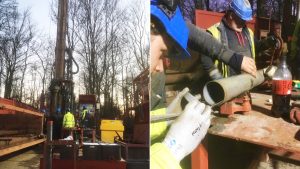
However, storing heat in natural aquifers at temperature levels greater than 50°C comes with many challenges regarding material use, recovery efficiency, groundwater quality, system integration, and societal engagement. At TU Delft, a HT-ATES system will be installed and operated in conjunction with the geothermal well. The installation, demonstration and research is partially performed by the PUSH-IT project funded by the European Commission. The HT-ATES system will be extensively monitored and used to optimise performance and minimise GHG emissions of the entire system. Key elements in the research and developments of the HT-ATES system are mapping the subsurface characteristics, which are highly variable due to them being a natural system (see the results of a downhole log and CT-scans of sampled material in Fig. 4) and impact on the heat distribution in the subsurface. In addition, key aspects of societal engagement, policy and permitting, and societal perceptions will be investigated.
TU Delft has its own district heating network (DHN). It consists of five different tracks and provides heating to the old buildings on campus. Originally, in the 1950s, a coal-fired boiler provided heat to these buildings. Currently, a combined heat and power plant and gas-fired boilers feed the DHN, but these will be largely replaced by the geothermal energy well and HT-ATES, and only run for peak supply and back-up. This will have the consequence of reducing the supply temperature of DHN. These conditions are representative of many other cities/buildings, where old buildings need to be retrofitted to be able to utilise lower temperature heating. Together with the large heat pump, the different tracks allow for experimenting with different optimisation approaches regarding insulation measures, control strategies and demand side management.
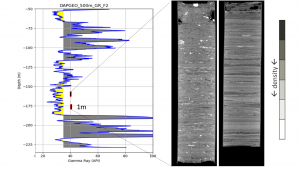
Outlook
With the Delft Subsurface Urban Energy Laboratory, the TU Delft community is ready to investigate resource efficiency during the entire operational life of the geothermal energy production and heat storage facility. With the deep well, we also create the ability to explore geothermal energy potential at increased depth. With core analysis providing ground truth information and geophysical monitoring providing information on changes in the temperature distribution over time, we aim to understand the heterogeneity of the geothermal reservoir, the existence of preferential flow paths, and possibly on the (re-)activation of presently undetected but existing faults.
The heat storage facility on the TU Delft campus allows us to monitor the efficiency and safety of operation and provide knowledge on how to deal with large fluctuations in the storage and production cycles. Finally, groundwater protection is an important topic of investigation. Producing hot water through shallow aquifers, as well as operating a HT-ATES system, will have an impact on the surroundings. Shallow subsurface monitoring of thermally induced flows, changes in geochemical reactions and biological activities will inform on how to protect the environment, deemed essential for public health and biodiversity. These aspects are all critical for upscaling the use of geothermal energy from a niche energy source to a major contributor to the energy system.
The research and facilities discussed in this article are used and implemented in our education. TU Delft offers various online courses, which are open to anybody in the world. In our on-campus education, an example is the heat-track in the Masters programme ‘Sustainable Energy Technology’.
Acknowledgements
This sort of facility cannot be realised without extensive work by a large group of colleagues and partners, of whom there are too many to list here. Key funding partners for the scientific part are the Dutch Research Council (NWO) via the EPOS-NL and EPOS-eNLarge projects, the European Commission Horizon Europe via funding of the PUSH-IT project, and commercial partners who invest in the infrastructure (Aardyn, EBN and Shell Geothermal). Within TU Delft, a wide variety of departments have contributed: the Faculty of Civil Engineering and Geosciences, Campus Real Estate, the Urban Energy and Powerweb institutes, and the Innovation & Impact Centre. Key colleagues within the Faculty of Civil Engineering and Geosciences are Susanne Laumann, Hemmo Abels, Guy Drijkoningen, Auke Barnhoorn, Denis Voskov, Liliana Vargas Meleza, Anne Pluymakers, Alexandros Daniilidis, Sebastian Geiger, and the implementation team. Key research partners are Utrecht University, KNMI and TNO from the EPOS-NL/eNLarge consortium and 19 partners from around Europe from the PUSH-IT consortium.
References
- Goldstein, B., G. Hiriart, R. Bertani, C. Bromley, L. Gutiérrez-Negrín, E. Huenges, H. Muraoka, A. Ragnarsson, J. Tester, V. Zui (2011): Geothermal Energy. In IPCC Special Report on Renewable Energy Sources and Climate Change Mitigation [O. Edenhofer, R. Pichs-Madruga, Y. Sokona, K. Seyboth, P. Matschoss, S. Kadner, T. Zwickel, P. Eickemeier, G. Hansen, S. Schlömer, C. von Stechow (eds)], Cambridge University Press, Cambridge, United Kingdom and New York, NY, USA
- IRENA, IEA and REN21 (2020), Renewable Energy Policies in a Time of Transition: Heating and Cooling, International Renewable Energy Agency, International Energy Agency and Renewable Energy Policy Network for the 21st Century, www.irena.org/publications/2020/Nov/Renewable-energy-policies-in-a-time-of- transition-Heating-and-cooling
- Stringfellow, W. T. and Dobson, P. F. (2021), “Technology for lithium extraction in the context of hybrid geothermal power”, Proceedings of the 46 th Workshop on Geothermal Reservoir Engineering, Stanford University, Stanford, California, 15-17 February 2021, https://pangea.stanford.edu/ERE/pdf/IGAstandard/SGW/2021/Stringfellow.pdf
- Sanjuan, B., Gourcerol, B., Millot, R., Rettenmaier, D., Jeandel, E. and Rombaut, A. (2022), “Lithium-rich geothermal brines in Europe: An up-date about geochemical characteristics and implications for potential Li resources”, Geothermics, Vol. 101/May, https://doi.org/10.1016/j.geothermics.2022.102385
- IRENA and IGA (2023), Global geothermal market and technology assessment, International Renewable Energy.Agency, Abu Dhabi; International Geothermal Association, The Hague. ISBN: 978-92-9260-495-0
- https://iea.blob.core.windows.net/assets/ada7af90-e280-46c4-a577-df2e4fb44254/Renewables2022.pdf
Please note, this article will also appear in the fourteenth edition of our quarterly publication.

